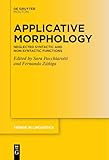Applicative Morphology : Neglected Syntactic and Non-syntactic Functions / ed. by Sara Pacchiarotti, Fernando Zuniga.
Material type: TextSeries: Trends in Linguistics. Studies and Monographs [TiLSM] ; 373Publisher: Berlin ; Boston : De Gruyter Mouton, [2022]Copyright date: ©2022Description: 1 online resource (VI, 477 p.)Content type:
TextSeries: Trends in Linguistics. Studies and Monographs [TiLSM] ; 373Publisher: Berlin ; Boston : De Gruyter Mouton, [2022]Copyright date: ©2022Description: 1 online resource (VI, 477 p.)Content type: - 9783110777857
- 9783110778021
- 9783110777949
- P241 .A66 2022
- online - DeGruyter
- Issued also in print.
| Item type | Current library | Call number | URL | Status | Notes | Barcode | |
|---|---|---|---|---|---|---|---|
 eBook
eBook
|
Biblioteca "Angelicum" Pont. Univ. S.Tommaso d'Aquino Nuvola online | online - DeGruyter (Browse shelf(Opens below)) | Online access | Not for loan (Accesso limitato) | Accesso per gli utenti autorizzati / Access for authorized users | (dgr)9783110777949 |
Frontmatter -- Contents -- 1 Introduction -- Part I: Americas -- 2 Typical and atypical applicative constructions in Yaqui -- 3 The functions of applicative morphology in Shiwiar -- 4 Applicatives and beyond: Barbareño Chumash -- 5 Applicative periphrastic constructions in the Colombian Spanish from The Andes -- 6 Spatial prefixes as applicatives in Harakmbut -- Part II: Africa -- 7 Valency and saliency in Bantu applicatives: A diachronic reanalysis -- 8 Neglected functions of the Bantu applicative in relation to Locations: new insights from Fwe (K402) -- 9 The applicative(-like) function of Nilotic directionals: Introducing themes -- Part III: Asia (including the Middle East) -- 10 An applicative analysis of Soranî “absolute prepositions” -- 11 Applicatives in Macro-Tani languages (Trans-Himalayan, Eastern Himalaya): Forms, functions and historical origins -- 12 Canonical and Non-canonical applicatives in Waray -- 13 The sociative/benefactive applicative construction and the introduction of attitude holders in Tibetan -- 14 Neglected functions of western Indonesian applicatives -- 15 The evolution of non-syntactic functions of applicatives: -i suffixation in Javanese and neighboring languages -- Subject index -- Language index
restricted access online access with authorization star
http://purl.org/coar/access_right/c_16ec
This book is about recurrent functions of applicative morphology not included in typologically-oriented definitions. Based on substantial cross-linguistic evidence, it challenges received wisdom on applicatives in several ways. First, in many of the surveyed languages, applicatives are the sole means to introduce a non-Actor semantic role into a clause. When there is an alternative way of expression, the applicative counterpart often has no valence-increasing effect on the targeted root. Second, applicative morphology can introduce constituents which are not syntactic objects and/or co-occur with obliques. Third, functions such as conveying aspectual nuances to the predicate (intensity, repetition, habituality) or its arguments (partitive P, highly individuated P), narrow-focusing constituents, and functioning as category-changing devices are attested in geographically distant and genetically unrelated languages. Further, this volume reveals that spatial-related morphology is prone to developing applicative functions in disparate languages and phyla. Finally, several contributions discuss the diachrony of applicative constructions and their (non-syntactic) attested functions, including a case of applicatives-in-the-making.
Issued also in print.
Mode of access: Internet via World Wide Web.
In English.
Description based on online resource; title from PDF title page (publisher's Web site, viewed 25. Jun 2024)


